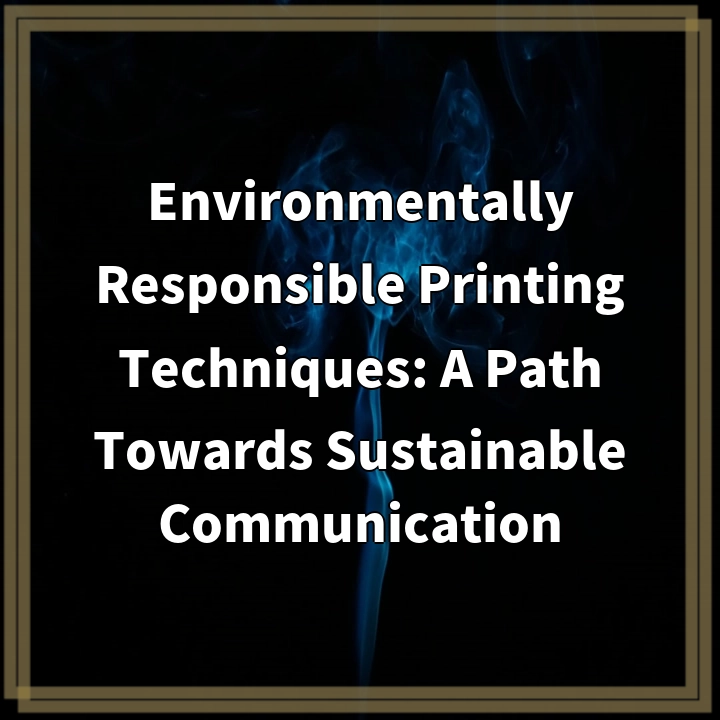
What it is:
Environmentally responsible printing techniques refer to methods and practices that aim to minimize the negative environmental impact of the printing industry. It involves adopting sustainable alternatives and technologies throughout the entire printing process, from design to disposal. By prioritizing eco-friendly materials, reducing resource consumption, and promoting proper waste management, environmentally responsible printing techniques help to achieve a more sustainable and responsible form of communication.
Real-World Problems:
Despite advancements in digital communication, printing still plays a significant role in various industries. However, traditional printing practices have considerable environmental consequences. Some of the real-world problems associated with conventional printing techniques include:
1. Deforestation and resource depletion:
Traditional printing relies heavily on paper, which contributes to deforestation and puts a strain on natural resources. The demand for paper leads to unsustainable logging practices and habitat loss, threatening biodiversity and disrupting ecosystems. Additionally, the production of paper requires extensive water and energy resources.
2. Chemical pollution:
The use of conventional printing inks, coatings, and solvents often involves toxic chemicals such as volatile organic compounds (VOCs) and heavy metals. These substances can be harmful to human health and the environment when improperly managed. Improper disposal of printing-related chemicals can contaminate water sources and soil, leading to long-term pollution.
3. Energy consumption:
Printing processes, particularly those involving large-scale commercial printing operations, consume significant amounts of energy. This energy comes primarily from fossil fuel sources, contributing to greenhouse gas emissions and climate change. The reliance on non-renewable energy sources in the printing industry further exacerbates the environmental impact.
4. Waste generation and landfill impact:
Printing generates substantial amounts of waste, including paper trimmings, misprints, and obsolete materials. Without proper recycling or waste reduction measures, much of this waste ends up in landfills, occupying space and contributing to methane emissions. Additionally, the disposal of non-biodegradable materials, such as plastic packaging and ink cartridges, further adds to the environmental burden.
By understanding these real-world problems, it becomes evident that adopting environmentally responsible printing techniques is crucial for mitigating the negative impacts of the printing industry. Transitioning towards sustainable alternatives and practices can help reduce environmental harm, conserve resources, and promote a more eco-conscious approach to communication.

Solutions for Environmentally Responsible Printing Techniques:
1. Sustainable sourcing and materials:
One key solution is to prioritize sustainable paper sourcing, such as using certified or recycled paper. These options help reduce deforestation and resource depletion. Additionally, exploring alternatives like tree-free papers made from agricultural waste or fibers can further minimize the environmental impact.
2. Eco-friendly inks and coatings:
Choosing environmentally friendly inks and coatings can significantly reduce chemical pollution. Opting for vegetable-based or soy-based inks, along with low VOC coatings, can help minimize the emission of harmful substances. Utilizing water-based inks instead of solvent-based ones also contributes to environmentally responsible printing.
3. Energy-efficient printing processes:
Implementing energy-efficient technologies and practices can reduce the environmental footprint of printing. Upgrading to energy-efficient printing equipment, optimizing printing schedules, and using renewable energy sources, such as solar power, can help minimize energy consumption and greenhouse gas emissions.
4. Waste reduction and recycling:
Creating a circular economy within the printing industry is essential for waste reduction. Implementing efficient paper usage, encouraging double-sided printing, and properly recycling paper waste can significantly reduce the amount of printing-related waste ending up in landfills. Recycling ink cartridges and other printing consumables is also crucial for reducing environmental impact.
5. Digital and print optimization:
Promoting digital alternatives can help reduce the need for printing altogether. Encouraging the use of electronic documents and online communication platforms can minimize paper usage. Additionally, optimizing print layouts and design to reduce excess ink or paper waste can contribute to environmentally responsible printing.
By adopting these solutions, the printing industry can move towards more environmentally responsible practices. Implementing sustainable sourcing, using eco-friendly materials and inks, reducing energy consumption, implementing waste reduction measures, and optimizing digital and print communication can collectively contribute to a more sustainable and responsible approach to printing.















